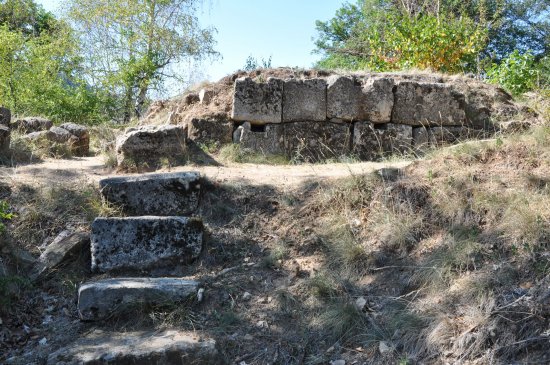 The Dacian fortress of Căpâlna poses one of the greatest challenges for Romanian restorers. The fortress, part of UNESCO’s heritage, is going to be rebuilt, thanks to a five million Euros project, financed by the European Union. The Dacian fortress walls will be restored two millennia after they were destroyed by the Roman army. Local authorities promise that these walls will be entirely rebuilt. Also, the land on which the old fortification stands will be strengthened.
The fortress of Căpâlna was built in the days of King Burebista. It was oval in shape. The thickness of the walls is about three metres, and the total length of the enclosure was about 270 metres. Access inside the fortress was made possible through a watchtower, with a 10 metres side, which served to protect the gateway. Up to a height of approximately 1.7 metres, this tower was built using the murus dacicus technique. It was partially destroyed and then rebuilt before the year 106, using slightly burned brick.
The Dacian fortress of Căpâlna poses one of the greatest challenges for Romanian restorers. The fortress, part of UNESCO’s heritage, is going to be rebuilt, thanks to a five million Euros project, financed by the European Union. The Dacian fortress walls will be restored two millennia after they were destroyed by the Roman army. Local authorities promise that these walls will be entirely rebuilt. Also, the land on which the old fortification stands will be strengthened.
The fortress of Căpâlna was built in the days of King Burebista. It was oval in shape. The thickness of the walls is about three metres, and the total length of the enclosure was about 270 metres. Access inside the fortress was made possible through a watchtower, with a 10 metres side, which served to protect the gateway. Up to a height of approximately 1.7 metres, this tower was built using the murus dacicus technique. It was partially destroyed and then rebuilt before the year 106, using slightly burned brick.The fortress was built on a high hill at an altitude of 610 metres and its strategic position overlooks the Sebes valley. The precinct walls were partially dismantled after the Dacian-Roman War in 101-102, when the Roman Emperor Trajan forced king Decebalus to give up a part of the fortifications.
The walls were rebuilt in haste around the Dacian-Roman War of 105 and 106. Other fortification elements were then created, including a defensive outer ditch, and two mounds with a ditch inside, which were designed the stop the first assault of the besiegers. The fortress was conquered and burned by the Romans in the year 106. The Dacian fortress also protected a civilian settlement, sheltering the families of the garrisoned soldiers.
The settlement was built on successive terraces, designed for dwelling. On the highest of these terraces a wooden tower was built, which was meant to monitor the surroundings and to signal the approach of the enemy.
The Roman conquest entailed destruction
The settlement was, in turn, destroyed in 106. Archaeological excavations have uncovered many Dacian artefacts from high quality ceramics to bronze vessels, some with a ritual role, silver ornaments, iron and bronze tools as well as Roman coins.
Travel info: Between Bucharest and Căpâlna there is a distance of 345 kilometres and between Cluj-Napoca and Căpâlna it is 128 kilometres.






